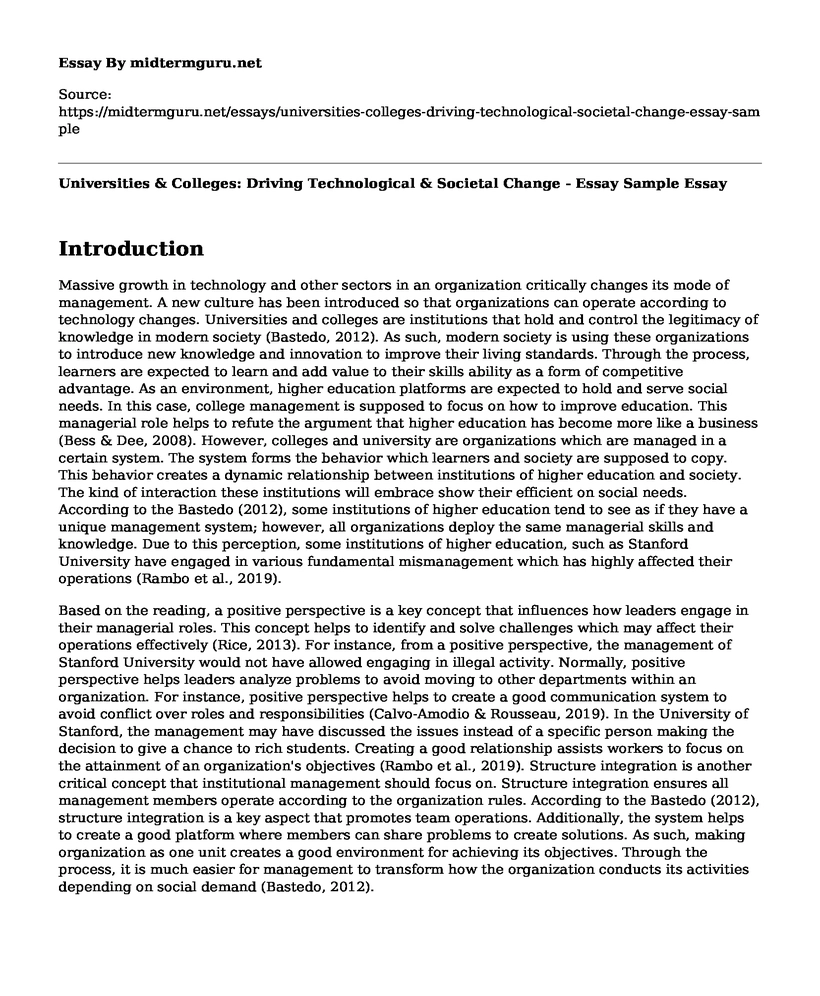Introduction
Massive growth in technology and other sectors in an organization critically changes its mode of management. A new culture has been introduced so that organizations can operate according to technology changes. Universities and colleges are institutions that hold and control the legitimacy of knowledge in modern society (Bastedo, 2012). As such, modern society is using these organizations to introduce new knowledge and innovation to improve their living standards. Through the process, learners are expected to learn and add value to their skills ability as a form of competitive advantage. As an environment, higher education platforms are expected to hold and serve social needs. In this case, college management is supposed to focus on how to improve education. This managerial role helps to refute the argument that higher education has become more like a business (Bess & Dee, 2008). However, colleges and university are organizations which are managed in a certain system. The system forms the behavior which learners and society are supposed to copy. This behavior creates a dynamic relationship between institutions of higher education and society. The kind of interaction these institutions will embrace show their efficient on social needs. According to the Bastedo (2012), some institutions of higher education tend to see as if they have a unique management system; however, all organizations deploy the same managerial skills and knowledge. Due to this perception, some institutions of higher education, such as Stanford University have engaged in various fundamental mismanagement which has highly affected their operations (Rambo et al., 2019).
Based on the reading, a positive perspective is a key concept that influences how leaders engage in their managerial roles. This concept helps to identify and solve challenges which may affect their operations effectively (Rice, 2013). For instance, from a positive perspective, the management of Stanford University would not have allowed engaging in illegal activity. Normally, positive perspective helps leaders analyze problems to avoid moving to other departments within an organization. For instance, positive perspective helps to create a good communication system to avoid conflict over roles and responsibilities (Calvo-Amodio & Rousseau, 2019). In the University of Stanford, the management may have discussed the issues instead of a specific person making the decision to give a chance to rich students. Creating a good relationship assists workers to focus on the attainment of an organization's objectives (Rambo et al., 2019). Structure integration is another critical concept that institutional management should focus on. Structure integration ensures all management members operate according to the organization rules. According to the Bastedo (2012), structure integration is a key aspect that promotes team operations. Additionally, the system helps to create a good platform where members can share problems to create solutions. As such, making organization as one unit creates a good environment for achieving its objectives. Through the process, it is much easier for management to transform how the organization conducts its activities depending on social demand (Bastedo, 2012).
Conclusion
In conclusion, organization management is highly influenced by how members engage in their daily activities. Positive perception and structural integration are essential concepts that change how institutions conduct their managerial roles. Through these concepts, an organization can effectively overcome some challenges which affect their operations. Senior leaders are supposed to ensure members focus on these concepts to improve their performance.
References
Bastedo, N.M. (2012). The organization of higher education: managing colleges for a new era. The Johns Hopkins University Press.
Bess, J. L., & Dee, J. R. (2008). College and university organization: Theory of effective policy and practice (Vol. 1) Dynamics of the system (Vol. 2). Stylus Publishing, LLC.
Calvo-Amodio, J., & Rousseau, D. (2019, January). The Human Activity System: Emergence from Purpose, Boundaries, Relationships, and Context. In Proceedings of the 17th Annual Conference on Systems Engineering Research, Washington DC, 3-4 April. Retrieved from https://cser.info/wp-content/uploads/2019/05/5.30_The-Human-Activity-System-Emergence-from-Purpose-Boundaries-Relationships-and-Context_2.pdf.
Rambo, E. A., Donyanavard, B., Seo, M., Maurer, F., Kadeed, T., de Melo, C. B., & Dutt, N. (2019). The information processing factory: Organization, terminology, and definitions. arXiv preprint arXiv:1907.01578. Retrieved from https://arxiv.org/pdf/1907.01578.
Rice, A. L. (2013). The enterprise and its environment: A system theory of management organization. Routledge.
Cite this page
Universities & Colleges: Driving Technological & Societal Change - Essay Sample. (2023, Feb 11). Retrieved from https://midtermguru.com/essays/universities-colleges-driving-technological-societal-change-essay-sample
If you are the original author of this essay and no longer wish to have it published on the midtermguru.com website, please click below to request its removal:
- Essay on Innovation Architecture of Organization and Management of Innovation
- The Purpose of Effective Organization of The Circle in Parts 1, 2 and 3
- Essay Sample on Teacher Pay in North Carolina
- Student Learning Journals: Tracking Academic Goals - Essay Sample
- My Code of Ethics: Golden Rule & Brazen/Iron Rules - Research Paper
- Code of Ethics for Best Giver Non-Profit - Research Paper
- Hanover-Bates: Premier Wholesaler of Synthetic Plating Compounds - Essay Sample







